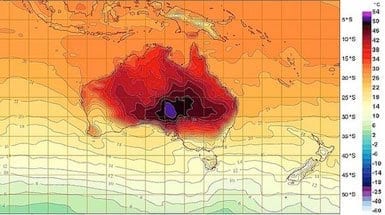
Australia had to add a new color to its weather maps this week.
Meteorologists used royal purple to denote an off-the-charts high temperature of 50 degrees Celsius (122 degrees Fahrenheit), part of an unprecedented heat wave and ongoing wildfires occurring down under this month. On the other side of the globe, 2012 proved the hottest year on record in the contiguous U.S., surpassing the previous record-holder by a full degree F (0.6 deg C). In short, global warming is continuing to turn up the heat—so what are we going to do about it?
The goal is simple: reduce greenhouse gas emissions to restrain future warming or even begin to draw down carbon dioxide concentrations in the atmosphere. But the challenge of achieving that goal is large—greenhouse gas emissions are intimately related to fossil fuel combustion, which is the motor of the global economy.
One idea to begin to solve this problem, mooted in 2004 by Princeton University mechanical engineer Robert Socolow and ecologist Stephen Pacala, was to identify what the scientists dubbed “wedges“—one billion metric ton reductions in carbon emissions that could be maintained for the next 50 years. So, for example, stopping any further increase in greenhouse gas emissions could be done by employing several of these wedges, such as doubling vehicle fuel efficiency or replacing coal-fired power plants with nuclear ones.
Employ enough of these wedges—seven in the estimation of Socolow and Pacala—and the problem of climate change begins to dissipate. And the researchers offered 15 potential wedges—ranging from carbon capture and storage to ending deforestation—to achieve the goal. As the co-authors put it in the paper presenting the idea published in Science: “Humanity already possesses the fundamental scientific, technical, and industrial know-how to solve the carbon and climate problem.”
Great! The only problem is: if we do indeed possess the know-how, we have yet to employ it. Eight years later, global greenhouse gas emissions continue to grow faster than ever. We have lost time, and that time will cost us, both in terms of the cost of combating climate change and the ultimate impacts.
According to a new analysis published online in Environmental Research Letters on January 9, the world now likely needs 12 wedges just to get back to the business-as-usual scenario outlined by Socolow and Pacala in 2004. Add another nine billion ton wedges if you want to stabilize emissions at last year’s levels, and add another 10 if you’d like to keep greenhouse gas concentrations from rising above 500 parts-per-million. Already, concentrations are at 394 ppm, up from 280 ppm before the dawn of widespread fossil fuel burning. That’s if you also want the global economy to continue to grow at the same time.
Read more . . .
via Scientific American – David Biello
The Latest Streaming News: Solve Climate Change updated minute-by-minute
Bookmark this page and come back often
Latest NEWS
Latest VIDEO







